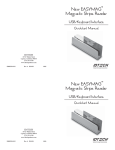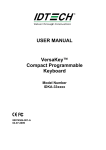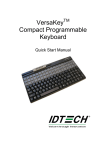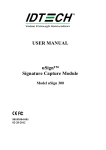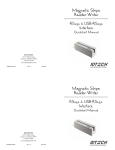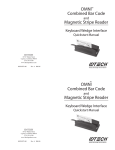Download ID TECH EasyMag
Transcript
TM New EASYMAG Magnetic Stripe Reader Keyboard Wedge Interface Quickstart Manual ID TECH 10721 Walker Street Cypress, California 90630 (714) 761-6368 www.idtechproducts.com 80080501-001 Rev. A R04/06 #403 AGENCY APPROVED DEFAULT SETTINGS TABLE Specifications for subpart B of part 15 of FCC rule for a Class A computing device. The EasyMag reader is shipped from the factory with the following default settings already programmed: LIMITED WARRANTY ID TECH warrants to the original purchaser for a period of 24 months from the date of invoice that this product is in good working order and free from defects in material and workmanship under normal use and service. ID TECH’s obligation under this warranty is limited to, at its option, replacing, repairing, or giving credit for any product which has, within the warranty period, been returned to the factory of origin, transportation charges and insurance prepaid, and which is, after examination, disclosed to ID TECH’s satisfaction to be thus defective. The expense of removal and reinstallation of any item or items of equipment is not included in this warranty. No person, firm, or corporation is authorized to assume for ID TECH any other liabilities in connection with the sales of any product. In no event shall ID TECH be liable for any special, incidental or consequential damages to Purchaser or any third party caused by any defective item of equipment, whether that defect is warranted against or not. Purchaser’s sole and exclusive remedy for defective equipment, which does not conform to the requirements of sales, is to have such equipment replaced or repaired by ID TECH. For limited warranty service during the warranty period, please contact ID TECH to obtain a Return Material Authorization (RMA) number & instructions for returning the product. THIS WARRANTY IS IN LIEU OF ALL OTHER WARRANTIES OF MERCHANTABILITY OR FITNESS FOR PARTICULAR PURPOSE. THERE ARE NO OTHER WARRANTIES OR GUARANTEES, EXPRESS OR IMPLIED, OTHER THAN THOSE HEREIN STATED. THIS PRODUCT IS SOLD AS IS. IN NO EVENT SHALL ID TECH BE LIABLE FOR CLAIMS BASED UPON BREACH OF EXPRESS OR IMPLIED WARRANTY OF NEGLIGENCE OF ANY OTHER DAMAGES WHETHER DIRECT, IMMEDIATE, FORESEEABLE, CONSEQUENTIAL OR SPECIAL OR FOR ANY EXPENSE INCURRED BY REASON OF THE USE OR MISUSE, SALE OR FABRICATIONS OF PRODUCTS WHICH DO NOT CONFORM TO THE TERMS AND CONDITIONS OF THE CONTRACT. Magnetic Track Basic Data Format Track 1: <SS1><T1 Data><ES><ENTER>* Track 2: <SS2><T2 Data><ES><ENTER>* Track 3: <SS3><T3 Data><ES><ENTER>* where: SS1(start sentinel track 1) = % SS2(start sentinel track 2) = ; SS3(start sentinel track 3) = ; for ISO, ! for CDL, % for AAMVA ES(end sentinel all tracks) = ? Keyboard Wedge Communication Default Settings Terminal type: IBM PC/AT Intercharacter delay: 2 ms Language: US English Start or End Sentinel: Characters in encoding format which come before the first data character (start) and after the last data character (end), indicating the beginning and end, respectively, of data. Track Separator: A designated character which separates data tracks. Terminator: A designated character which comes at the end of the last track of data, to separate card reads. LRC: Check character, following end sentinel. CDL: Old California Drivers License format. *Note: The <ENTER> characters (shown above) between tracks 1 & 2 and 2 & 3 denote the default character for this position, the Track Separator position. The <ENTER> characters shown for track 3 denotes the default character for this position, the Terminator position. 8 RUNNING THE UTILITY The reader is shipped from the factory with the “default configuration” programmed. The default configuration has the least restrictive settings, thus making it able to read all data of a standard encoded magnetic stripe card. See the default settings table for details. The configuration software can be downloaded from the ID TECH website. From the website, download the Configuration Utility ZIP file into a temporary file folder on your local hard drive. Double click the downloaded self extracting file and follow the screen prompts to expand the Zip file and run the SETUP.EXE application. The install wizard creates two new folders on the C: Drive. The new folder “IDTECH” and a sub-folder “MagSwipe Configuration Utility” are created in the “Program Files” folder. At the finish of the installation process, an “MagSwipe Configuration Utility” menu is installed in the programs folder of the Start menu. Connect the reader to the host computer and ensure it is getting power. Point to the “MagSwipe Configuration Utility” menu and click on the IDT icon. The utility will start at the Home Page with a menu on the left border. Point and click on the menu items as needed. For information on using the utility, point and click the HELP menu selection. 7 ©2006 International Technologies & Systems Corporation. The information contained herein is provided to the user as a convenience. While every effort has been made to ensure accuracy, ID TECH is not responsible for damages that might occur because of errors or omissions, including any loss of profit or other commercial damage. The specifications described herein were current at the time of publication, but are subject to change at any time without prior notice. ID TECH is a registered trademark of International Technologies & Systems Corporation. EasyMag and Value through Innovation are trademarks of International Technologies & Systems Corporation. Windows is a registered trademark of Microsoft Corporation. The USB (Universal Serial Bus) Specification is Copyright© 1998 by Compaq Computer Corporation, Intel Corporation, Microsoft Corporation, NEC Corporation. SPECIFICATIONS MAGSWIPETM CONFIGURATION UTILITY Power Requirements: 5 VDC +/-10% (50mV ripple maximum). Chassis ground connected to power supply GND and magnetic head case. Operating Current: About 30mA for decoded magnetic stripe (three tracks). Operating Temperature: 32° F to 131° F (0° C to 55° C). The magnetically encoded data on the magnetic stripe can be decoded (read) by magnetic card readers. The stripe data has a fixed format defined by the ISO standards. The ISO fixed format is not always convenient or useful for card reading applications. The solution is for the card reader to decode the stripe data and then arrange the data into useful format and content. The reader-formatted data is transmitted from an intelligent communication interface. Storage Temperature: -22° F to 158° F (-30° C to 70° C). Relative Humidity: Maximum 95% non-condensing. Magnetic Head Life: 1,000,000 passes minimum. Rail and Cover Life: 1,000,000 passes minimum. Magnetic Stripe Recording Method: Two-frequency coherent phase (F2F) compatible with ISO 7811, ANSI, AAMVA, and California DMV. Maximum Number of Tracks: 3 tracks. Swipe Speed: 3 to 60 inches per second, bidirectional. Card Thickness: .015 to .045 inches. Slot Width: .050 inches. Dimensions: Length: 5.14 inches (131mm). Width: 1.25 inches (32mm). Height: 1.6 inches (41mm). Weight: 8 oz. Cable Length: 5-foot straight cable. 1 The EasyMag is an intelligent magnetic stripe reader, which provides extensive formatting capability. In addition, characters can be added to the formatted data. To support the formatting capability, ID TECH provides an easy to use “MagSwipe Configuration Utility” software application. New file saving capabilities allow configurations to be saved and used again without having to repeat the full configuration process with each reader. The utility supports all reader interfaces. The operating systems supported are Windows 98, Windows 2000, and Windows XP. 6 TROUBLE SHOTTING PROCEDURES DESCRIPTION The troubleshooting process can be simplified by reviewing these reader operations. The EasyMag™ compact magnetic stripe reader can read 1, 2, or 3 tracks of magnetic stripe information. In addition, it has full data editing capabilities. The unit should emit one long beep when power is first applied. If it does not, then the unit is not receiving power. When connected to the host computer as a keyboard wedge, the EasyMag can be configured for compatiblity with the host’s software. The decoded data appears to the host as if it were entered manually by an operator through the keyboard. Once it has been confirmed that the unit is correctly powered, swipe a credit card. The LED will go off while decoding, then light green to indicate a “good read,” or red to indicate a “bad read.” Once the unit has indicated a “good read,” then proceed to check the interface cabling connections. This unit is fully programmable with a configuration utility. The data can be formatted with preamble/postamble and terminator characters to match the format expected by the host. When the reader is configured as a keyboard wedge, power is obtained from the host. No separate power supply is required. Installation of the reader is generally trouble free, but there are some considerations if problems occur. Do you have the proper cable? Most modern computers and terminals use a PC/XT/AT-compatible keyboard. However, the cable connecting it to the keyboard port may have variations in either the signal pins or the connector itself. Make sure that you have the proper cable for the computer/terminal with which you are interfacing. Does the keyboard work? Since the data from the keyboard must pass through the reader, the cabling connections are correct if the keyboard is operational. Can the host computer accept the data fast enough? Some computers and terminals are expecting the data rate from the keyboard port to come in at a keystroke rate, and might not be able to accept it as fast as the reader is transmitting. Adjust the intercharacter delay to simulate the effects of keystroke delays. 5 2 HOST CONNECTIONS CONFIGURATION The EasyMag reader is connected between the keyboard input port of the host computer and the keyboard itself using a “Y” adapter cable. The EasyMag must be appropriately configured to the application. Configuration settings enable the reader to work with the host system. These settings are programmed into the reader through a configuration utility. Once programmed, the configuration settings are stored in the reader’s non-volatile memory. The “Y” cable has a 6-pin mini-DIN female on one end, and a 6-pin miniDIN male on the other end. The cable is attached to the reader. To connect the reader to the host, turn off the power and disconnect the keyboard from the computer. Connect the keyboard to the female end of the “Y” connector. Then insert the male end of the “Y” cable into the keyboard port. This “wedges” the reader between the host and the keyboard. Manually-entered data from the keyboard passes through the unit to the host, leaving the keyboard fully functional at all times. Magnetic stripe data is read and transmitted to the host keyboard port, where it appears to the host as coming directly from the keyboard. This makes the reader, a data source, completely transparent to the host’s application software. In other words, if it is expecting data from the keyboard, that same data can be entered via the EasyMag with difference to the host. If the host computer’s application software is expecting the MagStripe data in a particular order and format, the reader’s output can be configured to output a simulated keyboard-entered data stream by re-arranging data blocks, adding terminating characters and special preamble and/or postamble character strings to the decoded card data. The EasyMag is shipped from the factory with the default settings already programmed. For a table of default settings, see the Default Settings Table. Use the Configuration Utility to re-configure the reader. See page 6. OPERATION The EasyMag magnetic stripe reader is easy to operate. Just follow these simple steps: 1. Make sure the reader is properly cabled and is receiving sufficient power. (See Troubleshooting if there is a cabling or power problem.) 2. To read a card, slide the card, in either direction, through the reader slot, with the magnetic stripe facing the magnetic head. 3. While swiping the card through the reader, the LED will go off. 4. Once the entire magnetic stripe has been read, the LED indicator will light up as green to signal a “good read.” If a good read is not obtained, the LED indicator will light up as red for about 1/2 second. 5. A beep will also sound to indicate a good read on each track. If all three tracks have been read successfully, the reader will beep three times. 3 4








